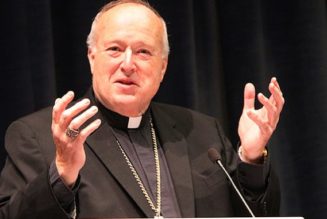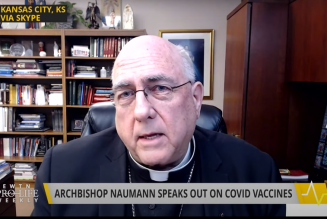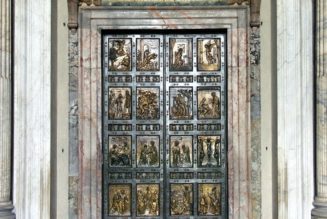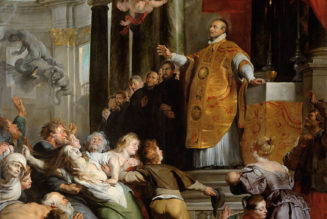
VATICAN CITY — Pope Emeritus Benedict XVI has died at the age of 95.
The Vatican made the announcement of his death at 10:30 am Rome time on Dec. 31 in a short statement translated into several languages.
“With sorrow I inform you that the Pope Emeritus, Benedict XVI, passed away today at 9:34 in the Mater Ecclesiae Monastery in the Vatican,” Vatican Press Office Director Matteo Bruni said. “Further information will be provided as soon as possible.”
The Vatican added that, from Jan. 2, the body of the pope emeritus will rest in St. Peter’s Basilica in the Vatican “for the faithful to bid farewell.”
Bruni later told reporters in a short press briefing that Benedict XVI’s funeral will be celebrated by Pope Francis at 9:30am on Thursday, Jan. 5, in St. Peter’s Square. He also disclosed that the pope emeritus received last rites on Wednesday afternoon after the Holy Mass.
The health of the pope emeritus, who served as the 265th Supreme Pontiff of the Catholic Church from 2005 until his unexpected resignation in 2013, had been steadily declining. Pope Francis alerted the world to his worsening condition on Dec. 28, saying he was “very ill.”
In recent years, he had experienced difficulty speaking and walking, although his mind remained alert, and he continued to receive visitors at least until Dec. 2. One of the last major milestones of his life was to celebrate 70 years as a priest, on June 29, 2021.
Benedict’s pontificate — which began with his election in April of 2005, succeeding Pope St. John Paul II, and ended with his almost unprecedented resignation in February of 2013 — was peppered by a series of trials, including the clerical sex-abuse crisis, the leaking of confidential papal documents, a Muslim backlash and communication mishaps. At the same time, these years marked a period of liturgical restoration that aimed to reverse the abuses of the past, the initiation of a process of reform of the Curia, most notably in the area of finance, and a continuation of the central themes of the post-conciliar New Evangelization of the Church that had been emphasized throughout John Paul II’s groundbreaking 25-year pontificate.
With Joseph Ratzinger’s death, the Catholic Church loses one of the greatest minds in its 2,000-year history. A leading German theologian who took part in the Second Vatican Council, he rose to worldwide prominence after his 1981 appointment as prefect of the Congregation for the Doctrine of the Faith (CDF).
The role earned him the disparaging moniker “God’s Rottweiler” from the media for his uncompromising defense of Catholic teaching in the face of open dissent within the Church and growing indifference to the faith in Western society at large.
Those who knew Joseph Ratzinger well, however, regarded him as a gentle and modest man of the Church who was blessed with a scholarly encyclopedic mind and defended the truths of the faith with clarity and power.
“Pope Benedict was a prophet, unafraid to challenge the perils and emptiness rampant in a world that had thrown aside the Truth revealed by God and nature and capitulated to the worship of self,” Cardinal Timothy Dolan of New York told the Register.
The pope emeritus was “capable of deeper theological reflection than his critics, who lack respect and are ideologically blinded,” Cardinal Gerhard Müller wrote in 2019, and was “able to get closer to the source of the fire that has set the Church’s roof ablaze.”
And Benedict summarized his mission with characteristic humility and concision.
“One has to make do with what time one has,” he observed in his retrospective 2016 book with Peter Seewald, Pope Benedict XVI, Last Testament: In His Own Words. “I was conscious that my task was of another kind: that I must try above all else to show what faith means in the contemporary world, and further, to highlight the centrality of faith in God, and give people the courage to have faith, courage to live concretely in the world with faith.”
Priest and Peritus
Born on Holy Saturday, April 16, 1927, in the Bavarian town of Marktl am Inn, Joseph Alois Ratzinger was the youngest of three children whose father was a policeman and mother was a hotel cook. Joseph and his two older siblings, Georg and Maria, remained remarkably close throughout their lives.
He was only 6 years old when the Nazis came to power in Germany in 1933, and his staunchly Catholic parents were hostile to the regime. He entered seminary at age 12, but two years later, in 1941, he was compelled to join the Hitler Youth, serving in an anti-aircraft battery and setting tank traps in Hungary before deserting with his brother in April 1945 and continuing with his priestly formation.
Ordained in 1951, he earned a doctorate in theology at the University of Munich in 1957.
Several teaching posts followed, and his striking gifts as a theologian drew the attention of Cardinal Josef Frings of Cologne. At the cardinal’s invitation, he served as peritus (theological expert) at the Second Vatican Council and was influential in the development of the Council’s dogmatic constitution on the Church, Lumen Gentium.
He had been critical of the closed, conformist elements of the pre-conciliar Church and was considered one of the more progressive figures in the Council. His desire to try to reconcile perennial teachings of the Church with modernity, in a “hermeneutic of continuity,” remained throughout his life.
In 1966, he accepted Swiss theologian Hans Küng’s invitation to lecture at the University of Tübingen, remaining there until 1969, when he moved to the University of Regensburg, where he later became vice president.
At Tübingen, his students remarked on his practice of celebrating Mass before he began his lecture, thus encouraging them to speak “with” God before they spoke “about” him, as one former student explained to his biographer, Peter Seewald. His lectures at the university served as the foundation for his 1968 book, Introduction to Christianity, an instant classic that offered a brilliant defense of biblical Christianity grounded in the Creed and is still included in the syllabi of Catholic seminaries and university theology departments.
But as his progressive-minded peers evoked the “spirit” of the Second Vatican Council, which had concluded in December 1965, to demand sweeping changes to Catholic doctrine and discipline, the Bavarian theologian judged that the ensuing confusion had left many of the faithful adrift.
“The kind of priest who is no more than a social worker can be replaced by the psychotherapist and other specialists,” he warned in a radio broadcast in 1969, as he prophesied that Christian communities would shrink in numbers, while growing in purity.
In 1975, to mark the 10th anniversary of the Council’s conclusion, he authored an article publicly articulating his conviction that the only proper way to interpret the Second Vatican Council was in strict continuity with previous Church councils, such as the Council of Trent and the First Vatican Council. Accordingly, its teachings could not be used to justify a rupture with the continuity of Tradition.
In 1977, to the surprise of almost everyone — including Father Ratzinger himself — Pope Paul VI named Father Ratzinger archbishop of Munich and Freising, and the archbishop-elect adopted Cooperatores Veritatis (“Co-Workers of the Truth”) as his episcopal motto.
He was quickly elevated to cardinal that year. And four years later, in 1981, Pope John Paul II appointed him prefect of the Congregation for the Doctrine of the Faith.
He remained at the side of the Polish pontiff until his death in 2005, serving as one of his closest advisers.
As “Co-Workers of the Truth” (which is drawn from the Third Letter of John), the Pope and prefect put their shoulders to the task of stabilizing the Church and fulfilling the Council’s true mandate of reform.
Prefect
While at the helm of the CDF, Cardinal Ratzinger sought to clarify and defend the faith, address new challenges to Catholic sexual and medical ethics, and end abuses in sacred worship.
He was responsible for a host of significant documents, including instructions in the 1980s detailing doctrinal flaws associated with Marxist-oriented liberation theologies, and the 2000 declaration Dominus Iesus, which reasserted the unique salvific role of Jesus and of the Catholic Church. Yet he also remained closely involved in John Paul’s efforts to engage other Christian denominations and faiths, especially Judaism and Islam.
Among his most important contributions was his oversight of the drafting process that resulted in the publication of the Catechism of the Catholic Church. Released in 1992, it represented a groundbreaking attempt to resolve persistent doctrinal confusion through the formulation of the truths of the faith.
In 2001, the CDF was given authority for investigating clergy sexual-abuse cases, and Cardinal Ratzinger oversaw the congregation’s expanded role in prosecuting cases from the United States and other countries, the result of a long-delayed reckoning with episcopal negligence and cover-ups that would shape the legacy of his own pontificate and cast a shadow on his final years as pope emeritus.
Cardinal Ratzinger was instrumental in securing the Holy See’s endorsement of the “Norms and Charter for the Protection of Young People,” which was approved by the U.S. Conference of Catholic Bishops in 2002 and became a model for episcopal conferences all over the world in dealing with the abuse crisis.
After John Paul’s death in 2005, Cardinal Ratzinger, as dean of the College of Cardinals, celebrated the Pontiff’s funeral Mass before a vast global audience. His homily expressed his personal sorrow at the passing of a beloved friend, while celebrating the extraordinary faith and courage of the deceased Pope, who had become increasingly debilitated by Parkinson’s disease in his final years.
The funeral Mass raised the prominence of the German prefect as the cardinals prepared to elect a successor who could match John Paul’s stature and continue his campaign to revitalize Catholicism in Europe.
On the first day of the conclave, Cardinal Ratzinger delivered an electrifying homily that warned of a “dictatorship of relativism that does not recognize anything as definitive and whose ultimate goal consists solely of one’s own ego and desires.”
The most powerful antidote to this tyranny, he said, is a friendship with Christ that “gives us a criterion by which to distinguish the true from the false.”
Pope
The following day, on April 19, he was elected pope at the age of 78. He took the name of Benedict XVI, principally after St. Benedict of Nursia, the patron saint of Europe and the founder of Western monasticism.
One of his self-declared goals was to strengthen Catholicism across Europe, and initiate a dialogue on the secular assumptions undergirding the continent’s political and legal systems.
During a 2011 address before the Bundestag, Germany’s parliament, he recalled the totalitarian rule of the Nazi state and warned that a de-Christianized politics left the continent “in a state of culturelessness,” and thus vulnerable to “extremist and radical movements [that would] emerge to fill the vacuum.”
In continuity with his predecessor, Benedict preserved an orthodox position on matters of sexuality, priestly celibacy and ecclesiastical governance.
Likewise, he took immediate steps to continue John Paul’s ecumenism, as well as his dialogue with Judaism and Islam.
In 2009, he erected a canonical structure that allowed Anglicans to become Catholics while retaining their patrimony and liturgy.
During his pontificate, Benedict wrote three encyclicals: Deus Caritas Est (God Is Love) in 2005; Spe Salvi (Saved by Hope) in 2007; and Caritas in Veritate (Charity in Truth) in 2009; and four post-synodal apostolic exhortations, including Sacramentum Caritatis (The Sacrament of Charity) on the Eucharist as the source and summit of the Church’s life and mission in 2007 and Verbum Domini (The Word of the Lord) on Holy Scripture in 2010.
In these texts, Benedict’s striking gifts as a theologian, philosopher and writer were on display, particularly the luminous clarity of expression and effective mining of central scriptural and liturgical images.
“You can trace his encyclical Deus Caritas Est to the seminal ideas of his book Introduction to Christianity and how we envision God,” the late Cardinal William Levada, CDF prefect during Benedict’s pontificate, told the Register in a 2017 interview.
“God is a relationship. God is love. The relationship between Father, Son and Spirit is fundamentally a spiritual relationship of love, and that is the fundamental reality of creation.”
“These are dramatically important insights he offered to a technological age that wants to solidify everything according to a scientific pattern,” said Cardinal Levada.
As the leader of the universal Church, Benedict issued 13 papal decrees (known as motu proprios), one of the most significant being Summorum Pontificum in 2007 that allowed unprecedented freedom for priests to celebrate the form of the Mass used before the reforms that followed the Second Vatican Council (Pope Francis abrogated the decree in July 2021). Benedict also found time to complete three volumes of his book Jesus of Nazareth.
He visited 29 countries during his eight-year pontificate, including the United States in 2008, during which he addressed the United Nations’ General Assembly in New York. In 2006, he made a tense visit to Turkey just a couple of months after he gave his famous “Regensburg Address” — a lecture that set off a firestorm of criticism in the Islamic world due to a quote from a 14th-century Byzantine emperor that was taken out of context by critics. But the incident yielded positive fruit in the Common Word initiative aimed at improving Catholic-Muslim relations and deterring Islamic extremism.
Further controversy erupted in 2009, when Benedict revoked the excommunications of four bishops of the Society of St. Pius X whom Archbishop Marcel Lefebvre (1905-1991) had consecrated in 1988 against the will of Pope John Paul II. Adding to the tensions, unknown to Benedict, one of the bishops, Richard Williamson, had denied the Holocaust.
Throughout his pontificate, Benedict had to contend with a flood of sexual and physical abuse allegations against priests. In 2006, in one of his most consequential actions, he ordered Father Marcial Maciel Degollado, the founder of the Legion of Christ, to leave public ministry and retire to a life of “prayer and penitence” following a Vatican investigation of allegations that he had sexually abused minors and seminarians.
Benedict was also required to address a continuing series of clergy abuse crises in Germany, Ireland and the United States, as well as accusations that he himself was responsible for covering up cases as archbishop of Munich and later as CDF prefect. The Vatican strenuously denied the charges against him, arguing that Benedict’s handling of the cases instead showed “great wisdom and firmness.”
Resignation and Pope Emeritus
On Feb. 11, 2013, Benedict shocked the world and the College of Cardinals by announcing in Latin at a consistory of cardinals that he would resign at the end of that month, citing age and health concerns. The first pope to resign since Gregory XII in 1415, the now-pope emeritus pledged to serve the Church “hidden from the world” and “dedicated to prayer.” He retired from public life and moved to a converted former convent in the Vatican Gardens but retained several external trappings of the papacy, including a white cassock and zucchetto, and the title of His Holiness.
Apart from occasional interviews, articles and contributions to books, including one with Cardinal Robert Sarah that reinforced the discipline of priestly celibacy in the Latin Rite, Benedict remained largely silent and only left his convent to visit his dying brother in 2020. His sister Maria, who spent much of her adult life managing his correspondence and caring for his personal needs, died in 1991.
The pope emeritus and Pope Francis maintained cordial relations. But when the distinctive priorities of their pontificates occasionally sparked controversy and a flurry of headlines followed, there were calls for new protocols governing the public role and statements of the next pope emeritus.
And in February 2022, as the German Catholic bishops continued to address the mishandling of historic clergy-abuse cases, the Archdiocese of Munich released the findings of its own archdiocesan investigation, which concluded that Benedict XVI “can be accused of misconduct” for his handling of four cases between 1977 and 1982, when he was serving there as its archbishop.
However, these claims were formally rebutted by four of his advisers, and the Vatican defended his strong response to the abuse crisis, including the prosecution and laicization of hundreds of clerical predators. In a recent interview with America magazine, Pope Francis reaffirmed this defense of Benedict, commenting, “The leader in taking these decisions was Benedict XVI.”
Preparing for Final Judgment
In a separate letter responding to the Munich investigation that served as a profound and memorable coda for his ministry as a priest, archbishop and pontiff, the pope emeritus asked for the forgiveness of abuse survivors, noting that he had “borne great responsibility in the Catholic Church.”
Concluding his letter, Benedict looked toward his judgment before God.
“Quite soon, I shall find myself before the final judge of my life. Even though, as I look back on my long life, I can have great reason for fear and trembling, I am nonetheless of good cheer, for I trust firmly that the Lord is not only the just judge, but also the friend and brother who himself has already suffered for my shortcomings, and is thus also my advocate, my ‘Paraclete,’” he wrote.
“In light of the hour of judgment, the grace of being a Christian becomes all the more clear to me. It grants me knowledge, and indeed friendship, with the judge of my life, and thus allows me to pass confidently through the dark door of death.”
“In this regard,” he concluded, “I am constantly reminded of what John tells us at the beginning of the Apocalypse: he sees the Son of Man in all his grandeur and falls at his feet as though dead. Yet He, placing his right hand on him, says to him: ‘Do not be afraid! It is I …’”
Join Our Telegram Group : Salvation & Prosperity








